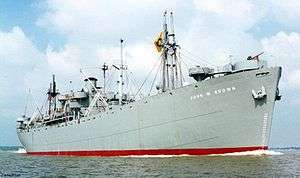SS Martin Behrman
SS Martin Behrman was an American Liberty ship built in 1944 for service in World War II. Her namesake was Martin Behrman, long-time mayor of New Orleans, Louisiana.
 Martin Behrman was a standard liberty ship, similar to SS John W. Brown, seen here. | |
| History | |
|---|---|
| Name: | Martin Behrman |
| Namesake: | Martin Behrman |
| Builder: | Delta Shipbuilding Company, New Orleans |
| Yard number: | 153 |
| Way number: | 2 |
| Laid down: | 25 October 1944 |
| Launched: | 4 December 1944 |
| Fate: | Scrapped, 1965 |
| General characteristics | |
| Class and type: | Type EC2-S-C1 Liberty ship |
| Displacement: | 14,245 long tons (14,474 t)[1] |
| Length: | |
| Beam: | 57 ft (17 m)[1] |
| Draft: | 27 ft 9 in (8.46 m)[1] |
| Propulsion: |
|
| Speed: | 11 knots (20 km/h; 13 mph)[1] |
| Range: | 20,000 nmi (37,000 km; 23,000 mi) |
| Capacity: | 10,856 t (10,685 long tons) deadweight (DWT)[1] |
| Crew: | 81[1] |
| Armament: | Stern-mounted 4 in (100 mm) deck gun for use against surfaced submarines, variety of anti-aircraft guns |
Among the Liberty ships, the Martin Behrman was an EC2-S-C1 Type with Maritime Commission hull number 2827. Like other Liberty ships, she was 441 feet (134 m) long and 56 feet (17 m) wide, carried 9000 tons of cargo and had a top speed of 11 knots (20 km/h). Most Liberty ships were named after prominent deceased Americans.[2]
This particular ship was built by Delta Shipbuilding Company in New Orleans. Her keel was laid on 25 October 1944 and she was launched on 4 December 1944. The Delta shipyard was started specifically for the war effort, at a site on the Industrial Canal near the Almonaster Avenue Bridge, immediately south of the present-day I-10 high-rise bridge. The yard was shut down after the end of the war.[3]
The Martin Behrman survived World War II and saw service in the Korean War.[4] In 1947 she was engaged in the Indonesian trade in defiance of a Dutch blockade, and on one voyage her cargo was confiscated by the Dutch Navy.[5][6][7]
She was scrapped at Portland, Oregon in 1965.[8] Her bow, along with the bows of many other Liberty ships, is buried at the Liberty Ship Memorial Park in Portland.[9]
References
- Davies, James (2012). "Liberty Cargo Ships" (PDF). ww2ships.com. p. 23. Retrieved 7 May 2012.
- "Liberty Ships built by the United States Maritime Commission in World War II". usmm.org. 2008. Retrieved 10 May 2012.
- "Delta Shipbuilding". shipbuildinghistory.com. 2011. Retrieved 10 May 2012.
- "American Merchant Marine Ships Participating in Korean War". usmm.org. 2008. Retrieved 10 May 2012.
- "Dutch Seize U.S. Vessel". The Atchison Daily Globe. Atchison, KS. AP. 7 March 1947. Retrieved 28 September 2015 – via Newspapers.com.

- Penders, L.M. (2002). "The West New Guinea Debacle" (PDF). papuaweb.org. p. 36. Retrieved 10 May 2012.
- "Dispatch 6/1947 Batavia". Australian Department of Foreign Affairs and Trade. 26 February 1947. Retrieved 10 May 2012.
- "Liberty Ships (M)". mariners-l.co.uk. 2011. Retrieved 10 May 2012.
- "Liberty Ship Memorial Park". gadoodles.com. 2010. Retrieved 10 May 2012.